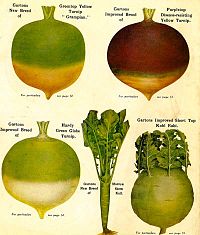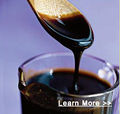Roots, Tubers and By-Products
Turnips and Swedes
Characteristics
Turnip and swede are related brassicas. They have good nutritive value, and typically a low dry matter and crude protein concentration. However, their protein tends to be very degradable.
| DM (%) | ME (MJ/kg DM) | CP (g/kg DM) | |
|---|---|---|---|
| Turnip | 9 | 11.2 | 120 |
| Swede | 12 | 12.8 | 110 |
Associated Problems
Excess intakes associated with milk taint in dairy cows. Nitrate and sulphur toxicity.
Mangel, Fodderbeet and Sugarbeet
- ! !! DM (%) !! ME (MJ/kg DM) !! CP (g/kg DM)
- Mangels have a high nitrate concentration if fresh (need to store for a few weeks). High intakes of fodderbeet can cause GI tract disturbances, hypocalcaemia and in rare cases death.
- Sugarbeet.jpg
Sugarbeet
Characteristics
Sugarbeet pulp is the residue following sugar extraction from sugarbeet root. It has a high dry matter and digestible fibre content, but a relatively low protein and phosphorus concentration. It is available in pellets or shreds, molassed or unmolassed. Can also be ensiled with distillers/brewers grains (draff) to form Grainbeet.
| DM (%) | ME (MJ/kg DM) | CP (g/kg DM) | |
|---|---|---|---|
| SB pulp (unmolassed) | 90 | 12.7 | 100 |
| SB pulp (molassed) | 87 | 12.5 | 110 |
Associated Problems
Choke, especially in horses (can increase it’s volume up to 6x; recommended to soak (ca. 1 litre per 200g) for 24 hours prior to feeding to horses).
Molasses
Characteristics
Molasses is the residue following sugar extraction from sugarbeet root (also get molasses from sugarcane). It involves crystallisation and separation of sugar from water extract. Molasses is a thick, black liquid that is very low in protein concentration but very high in soluble sugars. It is often added to sugarbeet pulp, proprietary feeds, mineral licks, and TMR rations.
| DM (%) | ME (MJ/kg DM) | CP (g/kg DM) | |
|---|---|---|---|
| Molasses | 75 | 12.9 | 50 |
Associated Problems
Can be laxative. Acidosis at high intakes.
| Roots, Tubers and By-Products Learning Resources | |
|---|---|
 Test your knowledge using flashcard type questions |
Animal Nutrition Flashcards |

